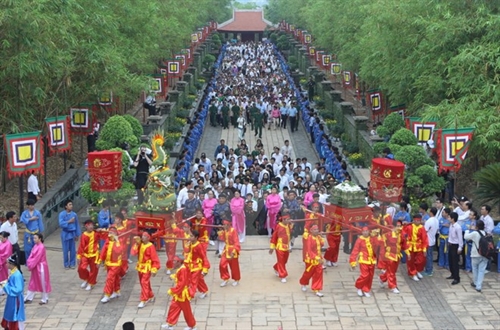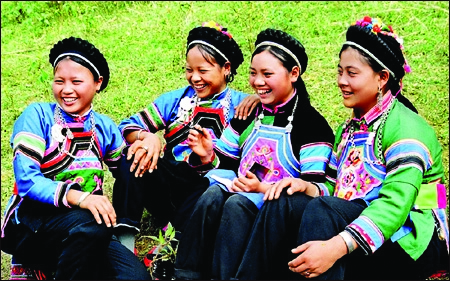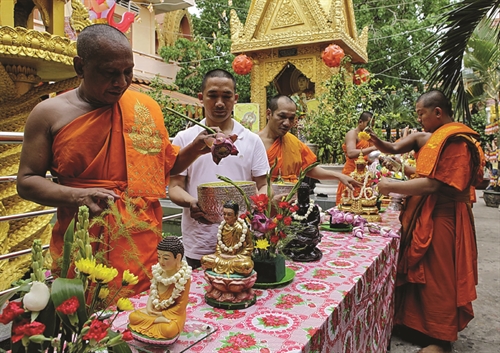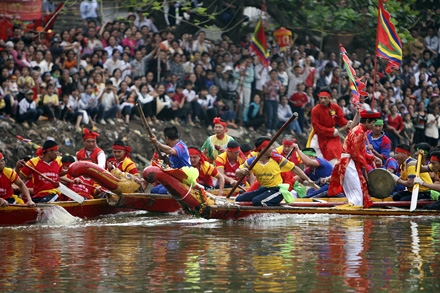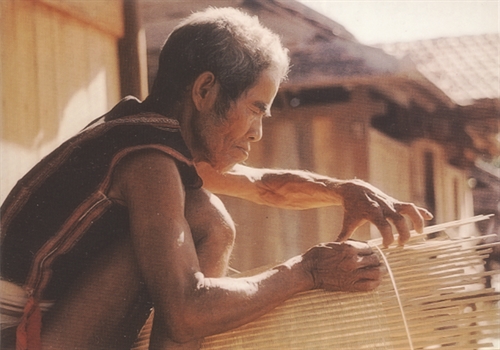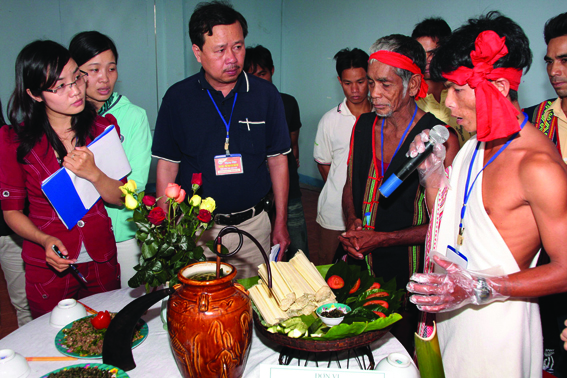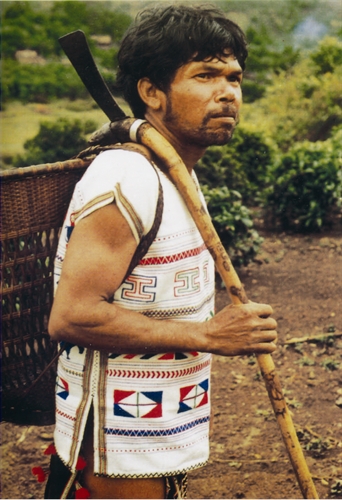Ta Thi Tam
Ethnology Institute
The whale worship festival typically reflects the original folk culture of fishing communities along the southern central and southern coasts of Vietnam, from Da Nang to Ba Ria - Vung Tau provinces.
The festival mirrors the belief and spiritual life of coastal villages which all have a temple devoted to Ca Ong (Mr Whale), which is believed to be the guardian angel of seafarers.
The whale cult was rooted from Cham people’s belief that Ca Ong embodies Cha Aih Va or Po Riyah, the powerful God of Sea, who can calm the waves and protect seafarers in distress.
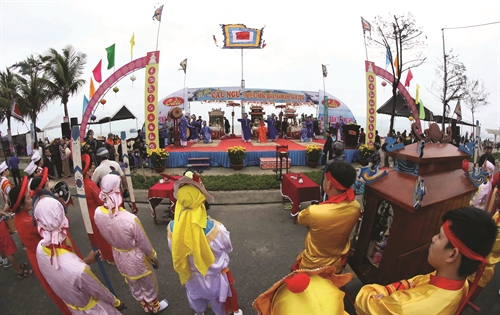 |
| Whale worship festival in Thanh Khe district (Da Nang city) __Photo: Tran Le Lam/VNA |
But Buddhist fishermen believe Ca Ong was the incarnation of Bodhisattva of Mercy, a salvor of seagoers. As Buddhist legend has it, one day the Goddess of Mercy strolled in the clouds above the East Sea and was so heartbroken to see fishing boats sunk by storms. She tore off her robe into pieces which turned into thousands of whales. The giant powerful whales saved the fishermen and led their boats to shelter. Reaching ashore, the rescued fishermen prostrated themselves on the sand toward the sea to express their gratitude and since then built temples along the coast to worship the creature.
The reverence of whale as a deity of fishing communities was upheld during the reign of the Nguyen dynasty. Historical tale told that Lord Nguyen Anh (1761-1820), who later became King Gia Long, was hit by a hurricane on Soai Rap river when he was on the way to escape from Tay Son soldiers. His boats and soldiers were on the brink of sinking amid a fierce gale when a giant whale appeared, leading the fleet safely to Vam Lang in Tien Giang province. When coming to the throne, Nguyen Anh bestowed on the whale the title of Nam Hai Dai Tuong Quan (His Excellency the Marshal of the Southern Sea) to commemorate his merit, and ordered coastal villages to build temples dedicated to Nam Hai Dai Tuong Quan.
The whale cult is not only to show the veneration of fishermen’s guardian angel but is believed to be linked to the prosperity of a fishing village. When a dead whale is washed ashore, fishermen will hold a solemn funeral for him. The fisherman who first sees the whale has the honor to be the son of Ca Ong and will host the funeral while the villagers will form a board to hold the funeral. According to fishermen’s custom, a person whose wife is pregnant or dead, whose parents have died, or who is in mourning for a family member is not supposed to attend the whale’s funeral.
The funeral is held like for a person. Villagers set up an altar on which they place wine, fruits and incense as offerings. Ca Ong is placed in front of the altar for villagers to pay tribute to before he is buried in the Ca Ong temple area. At a chosen date, Ca Ong is taken to his resting place in a procession led by the funeral board members, followed by Ca Ong’s son, a singing band, a drum band, a flag bearer team and finally villagers. Ca Ong is put on a flat wooden bed, shrouded with red cloth, and carried by young men. A ritual is conducted to ask for permission from the God of Earth to bury Ca Ong before he is lowered into the grave. The funeral conductor, Ca Ong’s son, and mourners walk around the grave, each throwing a handful of earth into the grave to bid their last farewell while the singing band and drum band standing in the shape of a boat sing, dance and play drum, praising Ca Ong’s protection and asking for his support for villagers. After the burial ceremony, another procession takes place to escort the spirit of Ca Ong to his altar in the temple where incense is burnt round the clock. All mourning clothes and other mourning objects are kept in the temple during the three-year mourning period before they are all burnt. After three years, villagers exhume Ca Ong’s bones and clean them with alcohol before putting them into an outer coffin for worship in the temple. When suffering poor catches, fishermen visit the Ca Ong temple, bringing offerings and praying for his protection. After praying, they pour the offered wine onto their fishing nets in hopes for good hauls.
The whale worship festival is held as a way to celebrate the death anniversary of Ca Ong. It is also a chance for fishermen to show their gratitude toward Ca Ong and other gods and seek their support for safe voyages and bumper hauls. The date of the festival varies from one locality to another.
The festival consists of rituals and festive activities. The rituals include three ceremonies, namely Ca Ong escort, god worship and village founder worship.
The offerings of the festival must not contain seafood and usually include a pig, two trays of sticky rice, wine, tea, fruits, flowers and votive papers.
The escort ceremony is conducted in the Ca Ong temple, aiming to escort the spirit of Ca Ong and those dying at sea to the temple to enjoy the offerings. When the ritual conductor is praying in front of the altar to invite the spirit of Ca Ong to return home, a singing band sings and dances outside. The band consists of 24 singers in green robes with red belts, who sing the ba trao (boat rowing) folk song and move gracefully in a rowing dance which praises unity and courage of fishermen in sailing on big waves to bring home rich catches. The band’s leading singer carries a white oar with a red handle on which is drawn a yellow dragon while others hold smaller black and white oars. The performance is backed by a music band composed of drum, clarion, bamboo flute and two-cord fiddle players. After the praying rite, the escort ritual begins with a big boat beautifully decorated with lanterns, flower garlands and flags slowly heading for the sea. The boat carries village elders and the music band and singing band and an altar with a tray of offerings. It is escorted by smaller boats of villagers. Sailing about four or five kilometers away from ashore, the big boat stops and the singing and music bands start their performances while the village elders burn votive papers, calling the spirit of Ca Ong to return to the village. After that, the boats sail back to the shore and the altar is carried back to the temple, a symbolic act of escorting Ca Ong to his home.
The Ca Ong escort ceremony is followed by the other two ceremonies dedicated to the gods and village founders in which the ritual conductor prays to the gods and deities and ask for their protection and support.
After the praying ceremonies are festive activities, including singing folk songs and playing folk games such as boat racing, swimming, duck chasing, crab catching, wrestling, tug of war and stilt walking.-

